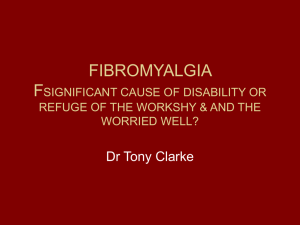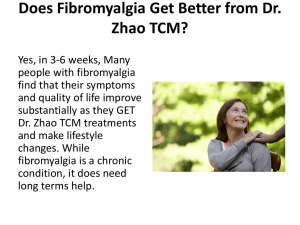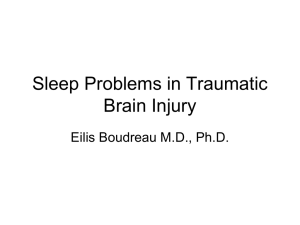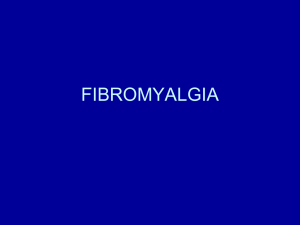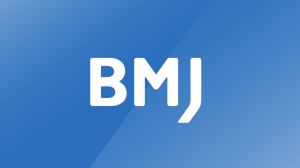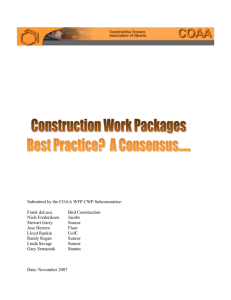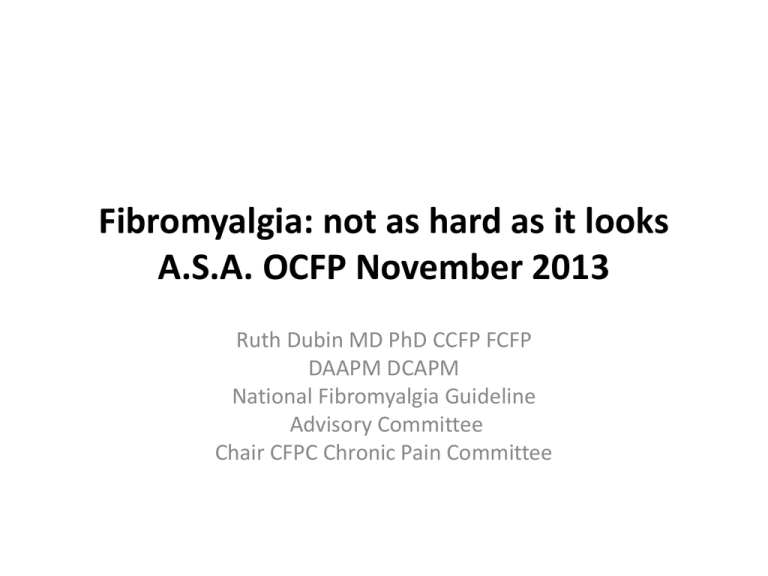
Fibromyalgia: not as hard as it looks
A.S.A. OCFP November 2013
Ruth Dubin MD PhD CCFP FCFP
DAAPM DCAPM
National Fibromyalgia Guideline
Advisory Committee
Chair CFPC Chronic Pain Committee
CFPC CoI Templates: Slide 1
Faculty/Presenter Disclosure
• Faculty: Ruth Dubin
• Relationships with commercial interests:
–
–
–
–
Grants/Research Support: not applicable
Speakers Bureau/Honoraria: not applicable
Consulting Fees: None
Other: None
CFPC CoI Templates: Slide 2
Disclosure of Commercial Support
• This program has received financial support from no one in the form of
• This program has received in-kind support from no one in the form of
• Potential for conflict(s) of interest: NOT APPLICABLE
– [Speaker/Faculty name] has received [payment/funding, etc.] from
[organization supporting this program AND/OR organization whose product(s)
are being discussed in this program].
– [Supporting organization name] [developed/licenses/distributes/benefits from
the sale of, etc.] a product that will be discussed in this program: [insert
generic and brand name here].
CFPC CoI Templates: Slide 3
Mitigating Potential Bias
• Content on pharmaceuticals is minimal
• Any discussion of off-label use of medications is based on
recommendations made by the Canadian Fibromyalgia
Guideline
Faculty/Presenter Disclosure
• Faculty: Ian Shiozaki
• Program: 51st Annual Scientific Assembly
• Relationships with commercial interests:
– speaker : GSK, Pfizer, AstraZeneca, Merck, Abbott, Bayer, Eli Lilly,
Roche, Novartis Boehringer
– Advisory board: BMS, Lundbeck, AstraZeneca, Pfizer, Eli Lilly,
Disclosure of Commercial
Support
• This program has received financial support N/A
• This program has received in-kind support from N/a
• Potential for conflict(s) of interest:
– N/A
Mitigating Potential Bias
• N/A
True or False?
• Fibromyalgia is a diagnosis of exclusion. T/F
• Rheumatology referrals and/or extensive
testing are required before one can make a
definitive diagnosis of FMA. T/F
• I don’t have the time or skills to deal with
Fibromyalgia patients. T/F
2012 Canadian Fibromyalgia
Guidelines
Executive Committee
Dr. Mary-Ann Fitzcharles, Peter A. Ste-Marie,
Dr. Don L. Goldenberg, Dr. John X. Pereira, Dr. Susan Abbey,
Dr. Manon Choinière, Dr. Gordon Ko, Dr. Dwight Moulin,
Dr. Pantelis Panopalis, Johanne Proulx, Dr. Yoram Shir
*Fitzcharles at al 2013. CMAJ. May 15,
2013 DOI 10.1503/cmaj.121414
*Fitzcharles et al 2013. Pain Res. Manage.
18(3):119-126
NOT ANOTHER GUIDELINE!!!
m fitzcharles
Three new concepts…
• FM patients are best managed in primary care
setting
• Multimodal treatments ideal, with only
modest effect of drugs
• Maintain function and remain in workforce
The ideal treatment of CNCP*
MOVEMENT
Physical / Rehabilitative
SELF MANAGEMENT
MIND
Psychological
And Sleep
MEDICINE
Medications &
Interventions
*(R Jovey, Canadian Pain Society,2009-with input from R.Dubin)
Also see: Action Plan for the organization and delivery of chronic pain services in Nova Scotia, 2006
Why develop Guidelines?
• Recent guidelines ±10 years old
• Advances in understanding FM
– Neurophysiologic
– Treatments
• New diagnostic criteria (ACR 2010)*
• Call for guidance & direction
– Requested by Canadian Pain Society
*Wolfe at al. 2010. Arthritis Care and Research 62(5):600
The care gap…
• Prevalence of FM……2%
• Delay in diagnosis…..5 yrs
• ↓ health care use after diagnosis
• Improved health after diagnosis
m fitzcharles
Guidelines address three broad concepts in
46 recommendations
• Diagnosis and evaluation
• Management
• Patient trajectory and follow-up
12
23
11
new clinical concepts regarding FM have been
incorporated into these guidelines.
The guide…diagnosis
DO NOT USE CRITERIA TO DIAGNOSE AN INDIVIDUAL PATIENT
• FM is a clinical construct
• Pain is the pivot + sleep problems, fatigue, cognitive changes etc
– 2/3 pain, 1/3 other
• Patient must be examined
– To exclude other physical abnormality
– Tender points not needed
• Simple blood testing only
FiRST Questionnaire
Sensitivity: 90.5% Specificity 85.7%
Perrot S et al Pain 150 (2010) 250-256
FiRST © Serge Perrot, Didier Bouhassira, REDAR, 2010. All rights
reserved.
Development of Chronic Widespread Pain over a 12 year
period
1R&D-centre,
Stefan Bergman1
Spenshult hospital, Oskarström, Sweden
Conclusions
Results
Subjects move to and from chronic widespread pain
(CWP) over time.
1582 subjects (65%) responded at the 12 year
follow up. Out of 959 subjects that had reported
NCP at baseline, 66 (7%) reported CWP at follow
up. Out of 192 subjects that had reported CWP
at baseline, 35 (18%) reported NCP at follow up.
Predictive factors differ between subjects with no
chronic pain (NCP) at baseline that develop CWP,
and subjects that improves from CWP to NCP over
a twelve year period.
The results suggest different pathogenesis in the
two ends of the pain spectrum.
Background
Chronic widespread pain (CWP) is often regarded as
one end in a spectrum of more or less extensive pain
distribution in the body. We have previously reported
that subjects move to and from CWP over a three year
period.
The aim of the study was to describe the multifactorial
process of pain development over a 12 year period.
The development of CWP from NCP over
12 years was predicted by:
-being aged 34-46
OR 2.5; 95% CI 1.2-5.4
- low educational level
OR 3.0; 95% CI 1.6-5.6
- being an immigrant
OR 2.4; 95% CI 1.1-5.1
- problems falling asleep OR 8.2; 95% CI 3.0-22.1
The improvement to NCP from CWP over
12 years was predicted by:
- never being a smoker
OR 3.8; 95% CI 1.4-10.0
- drinking alcohol weekly OR 3.5; 95% CI 1.1-11.4
- no nightly awakenings OR 4.5; 95% CI 1.1-17.9
Method
A baseline postal survey to 2425 subjects from the general population aged 20-74. Localisation
of pain was reported by a drawing of the body. Subjects were classified as having no chronic pain
(NCP; n=1466), chronic regional pain (CRP; n=588), or CWP (n=303). 68 subjects could not be
classified. Pain development was followed over 12 years. The predictive values of baseline
background factors (age, sex, education, smoking, alcohol consumption, immigrant, sleep
structure) were analysed by multivariate logistic regression.
NCP
CRP
stefan.bergman@spenshult.se
CWP
www.fou-spenshult.se
Examples of Body Maps in FM
From Ceko M, Fitzcharles M.
and P Ste-Marie
A descriptive analysis of the
Body Map in patients with
Fibromyalgia
Canadian Pain Society 2012
CONCLUSION
No tender points does not mean you do not examine patient
Pic TP
m fitzcharles
Seek and
Ye Shall Find:
HI TECH TOOLS:
•
•
•
•
•
•
•
Cotton balls
Safety pin
Paper clip
Brush
Tuning fork
Warm and cold water
Your hands
What conditions not to miss?
• Endocrine
• thyroid, parathyroid
• Neurological
• MS, myasthenia gravis, neuropathy
• MSK disease
• early inflammatory arthritis, SLE, myositis, PMR,
hypermobility
• Psychiatric
• Depression, borderline personality, drug seeking,
somatization
• Drugs
• statins, aromatase inhibitors, PPI’s, bisphosphonates,
chemotherapy
m fitzcharles
Fibromyalgia?
• 48 y.o. female
• Referred with diagnosis of
FMA, lots of psychosocial
stress
• History of AM stiffness
• Sometimes so bad she
had to crawl up the stairs
• No allodynia, no typical
tender points
• History of iritis
• Tender over her joints, no
swelling etcl
The guide…diagnosis cont.
• As early as possible (level 5)
• Primary care is ideal setting (level 1) : early
diagnosis reduces disease-related anxiety (major
driver of healthcare utilization: THERE MUST BE
SOMETHING TERRIBLY WRONG WITH ME!)
– Specialist referral only if (level 5)
• Atypical symptoms
• Difficulties in management
• eg. sleep specialist, psychologist
The guide…diagnosis cont.
• Access to team member for support (level 3)
• Healthcare professionals
– knowledgeable (level 5)
– Empathetic, shared decision-making (level 3)
• Contributing factors such as genetics or triggering events must
not hinder care(level 5)
• ACR 2010 criteria (level 3)
– May validate clinical diagnosis
Treatment objectives
Think…………….
• symptom based treatments
• mechanisms based treatments
– Improve
• symptoms
• function
Do no harm
m fitzcharles
The guide…management key points
• No ideal treatment
• Patient tailored approach (level 5)
– Symptom-based management
– Non-pharmacologic & pharmacologic strategies
• Aim to
– symptoms
– Maintain / improve function
The guide…management key points
• Self-management strategies are imperative
(level 1)
• Internal locus of control
– Patient active participant!! (level 1)
– Multimodal approach (level 1)
– Realistic goals, coping strategies (level 5)
– Pacing, but continue normal life (level 4)
The guide….non pharma treatments
• Exercise (level 1)
– Best available evidence
– Any type
• aerobics, water based, stretching, etc.
• CAM
– Insufficient evidence (level 1)
– Encourage disclosure of use (level 5)
Chronic Pain Self-Management*
WHAT IS SELF MANAGEMENT?
“ The individual’s ability to manage the
symptoms, treatment, physical and social
consequences and lifestyle changes inherent in
living with a chronic condition”
Barlow 2002
* SLIDE CONTENT COURTESY OF DR SANDRA LEFORT, MEMORIAL UNIVERSITY
Chronic Pain Self-Management*
• Based on the Stanford Chronic Disease SelfManagement Program (K Lorig)
• Active is better than passive
• Keep Wellness in the foreground (no more PAIN
DIARIES!)
• The patient is the “expert” who works in
partnership with their HCP
• The patient takes responsibility for their own
health, uses their mind for pain management, uses
pacing, problem-solving, action plans and goalsetting
http://patienteducation.stanford.edu/programs/cpsmp.html
Mindfulness Meditation for Chronic Pain*
• Develop nonjudgmental awareness of
moment-to-moment experience within a
context of openness, kindness, tolerance and
acceptance of perceptible sensory, mental and
emotional phenomena.
• Can improve coping and health-related quality
of life in many chronic conditions including
chronic pain.
*Pain. 152 2011:361-369
Systematic Review of MBSR in FMA, IBS, Lakhan and Schofield PLoS One 2013
Aug 26 (8)
MINDFULNESS PREVENTS MD BURNOUT
Fortney et al. 2013 Ann Fam Med 11(5):412
MOVEMENT IS KEY
• Tai Chi Wang et al. NEJM 2010: 363 (8): 744
• Qi Gong (Mindful Movement/Meditative
Exercise) Sawynok et al. Evidence Based Complementary and
Alternative Medicine. 2013.
• Aerobics and Water exercise Mannerkorpi and
Henriksen. 2007. Best Practise and Clin. Research Rheumatology. 21:513
• Yoga
Carson et al. 2010. Pain 151: 530
m fitzcharles
The guide…. pharma treatments
•
•
•
•
•
No perfect drug
Lowest dose, gradual increase (level 5)
Expect only a modest response
Consider combination drugs (level 5)
Be knowledgeable regarding drug mechanisms
(level 5)
• Constant evaluation re risk vs. benefit (level 5)
Cautions re pharmacologic treatments
• Change 1 thing at a time
• Side effects often similar to symptoms of FM
• Caution re dependency on pills which fosters
“passivity”
Symptom based management
•
Pain
–
–
–
–
–
•
Sleep
–
–
–
–
–
•
Analgesics (simple, mild NSAIDs, weak opioids)
Anticonvulsants (gabapentinoids)
Antidepressant group
Opioids
??? Dopamine agonists
Gabapentinoids
TCA’s
Benzodiazepines
Cannabinoids,
Atypical agents…quietapine, trazadone, sodium oxybate
Mood
– Your best choice taking pt individual characteristics
•
Fatigue
– Bupropion, methylphenidate, modafinil
The art of FM pharmacotherapy
•
•
•
•
Patient tailored treatment
Pain, fatigue & mood+++….SNRI
Pain & sleep++++…..anticonvulsant
TCA’s still have a place
• LOW, LOW doses of drugs
The guide…. pharma treatments cont.
•
•
•
•
•
WHO step-up analgesic ladder (level 5)
NSAIDS – low dose, short use (level 5)
Tramadol – moderate/severe pain (level 2)
Strong opioids – discouraged (level 5)
Cannabinoid (pharma) – sleep (level 3)
Patients choice of medications
• Internet survey ..2500 FM patients USA
• Most common medications
– Acetaminophen, ibuprofen, naproxen,
cyclobenzaprine, amitriptyline, ASA
• Perceived as best
– hydrocodone, aprazolam, oxycodone, zolpidem,
cyclobenzaprine, and clonazepam.
Pharmacologic treatments
….mechanism based
• Anticonvulsants
– Gabapentinoids
sensitization
• Antidepressants
– norepinephrine
– serotonin
– dopamine
descending inhibition
• ? Dopamine
central
m fitzcharles
Mechanism based: descending pathways
serotonin
norepinephrine
opioids
cannabinoids
m fitzcharles
The guide…. pharma treatments cont.
• Anticonvulsants
– Explain mechanism to patient (level 5)
– Low dose (level 1)
• Antidepressants
– Explain mechanism to patient (level 5)
– TCAs, SSRIs & SNRIs can be used (level 1)
– Choice – MD knowledge, Pt characteristics (level 5)
How low can you go?
•
•
•
•
Amitriptyline:
Duloxetine:
Pregabalin:
Gabapentin:
10mg at bedtime
30mg in am with food*
25-50mg with supper*
100mg with supper
Consider polypharmacy (but no evidence)
*I start even lower
Antidepressants effects in FM
similar to that in low back pain
Standardized Mean Difference in Pain Improvement
Favors Placebo
Favors Treatment
Jenkins, et al. 1976 (imipramine)
Alcoff, et al. 1982 (imipramine)
Hameroff, et al. 1984 (doxepin)
Ward, et al. 1984 (desipramine/doxepin)
Pheasant, et al. 1983 (amitriptyline)
Goodkin, et al. 1990 (trazodone)
Atkinson, et al. 1998 (nortriptyline)
Atkinson, et al. 1999 (maprotiline)
Atkinson, et al. 1999 (paroxetine)
Dickins, et al. 2000 (paroxetine)
0.41 (0.22-0.61)
Overall (95% CI)
-1.6
0
Standardized Mean Difference
Salerno SM, et al. Arch Intern Med. 2002;162:19-24.
m fitzcharles
1.6
Sleep and Fatigue
• Sleep: many have restless legs
pramiprexole (small studies: pathological gambling)
• Fatigue: exercise, activity, pacing
• ??? Stimulants
The guide…patient trajectory
• Follow-up time interval depends on MD
judgment (level 5)
• New symptoms
– Evaluate using clinical judgment (level 5)
• FM symptoms persist, wax and wane (level 3)
• No value to dwell on past lifetime events,
move forward (level 5)
• Empathetic and supportive relationship with
PCP is extremely important!
The guide…patient trajectory cont.
• Poor outcome when (level 5)
– Passive patient
– External locus of control
– Untreated prominent mood disorder
• Outcome tools
– Patient Global Impression of Change (level 3)
– Goal attainment (level 5)
– Do not use tender points for outcome (level 3)
The guide…work and cost
• Retention in workforce encouraged (level 3)
• Rehab program if necessary (level 5)
• Reduce costs by treating depression (level 3)
When do things go wrong?
• MD
– Wrong diagnosis
– Not attending to mood, sleep
– Over treating….pills, investigations
• Patient
– No goals, wants magic pill, unrealistic expectations
– The passive, negative patient
– Secondary gain
• Financial
• Social support
• Psychological support
Key points…
• FMA is a condition resulting from maladaptive
neuroplasticity
– Primary setting is recommended
– Do not over medicalize patient
• Non-pharma strategies very important
– Patient self management
• Symptom-based management
– No ideal drug
– Drugs show modest effects only
• Encourage retention in workforce
• Relationship with a supportive PCP is crucial
True or False?
• Fibromyalgia is a diagnosis of exclusion. T/F
• Rheumatology referrals and/or extensive
testing are required before one can make a
definitive diagnosis of FMA. T/F
• I don’t have the time or skills to deal with
Fibromyalgia patients. T/F
Thank you
See Handouts
For resources
m fitzcharles
OPIOID MANAGER (UPDATED):
•
http://nationalpaincentre.mcmaster.ca/opioidmanager/opioid_manager_download.html
• Open to all members
• May indicate interest in one or more Programs
To indicate interest or get more information:
• www.cfpc.ca/SIFP/
• sifp@cfpc.ca
OTHER RESOURCES
mmap.machealth.ca

